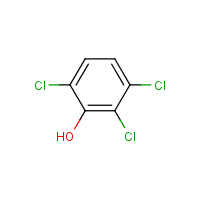2,3,6-Trichlorophenol
Agent Name
2,3,6-Trichlorophenol
CAS Number
933-75-5
Formula
C6-H3-Cl3-O
Major Category
Other Classes

Synonyms
Phenol, 2,3,6-trichloro-; [ChemIDplus] 1-Hydroxy-2,3,6-trichlorobenzene; [ICSC] UN2020
Category
Chlorophenols
Description
Colorless solid; [ICSC] May also be in the form of purple solid; [CAMEO] White to brown solid with a pungent phenolic odor; [MSDSonline]
Sources/Uses
"Chlorinated phenols are used as intermediates in the synthesis of dyes, pigments, and phenolic resins. Certain chlorophenols also are used directly as flea repellents, ... mold inhibitors, antiseptics, disinfectants, and antigumming agents for gasoline." [HSDB] Used as bactericide, fungicide, and to make pesticides; [EPA OHM/TADS]
Comments
A skin, eye, and respiratory tract irritant; May cause hyperthermia and convulsions after ingestion; [ICSC] Prolonged contact corrosive to eyes; May cause skin burns, hyperthermia, liver and kidney damage, and convulsions; [CAMEO] An irritant; Effects in high-dose animal studies include convulsions or effect on seizure threshold; [MSDSonline] See "CHLOROPHENOLS."
Biomedical References
Exposure Assessment
Vapor Pressure
0.00246 mm Hg
Explanatory Notes
Flash point = 78 deg C; [ICSC] The Guide in the Emergency Response Guidebook is for "Chlorophenols, solid."
Adverse Effects
Hepatotoxin
Hepatoxic (a) from occupational exposure (secondary effect) or (b) in animal studies or in humans after ingestion
Nephrotoxin
Yes
Dermatotoxin
Chloracne
IARC Carcinogen
Possible (2b)
Other Poison
Uncoupler
Diseases, Processes, and Activities Linked to This Agent
Diseases
Occupational diseases associated with exposure to this agent:
Processes
Industrial Processes with risk of exposure: